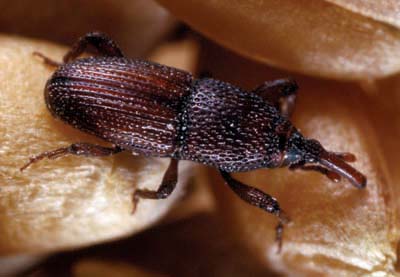
Adult granary weevil, Sitophilus granarius.
(Photographer: L.J. Buss, University of Florida)
The granary weevil is considered one of the most important grain pests, sometimes causing complete destruction of commercially stored grain. This weevil prefers a cooler climate and in the U.S. is not often found south of North Carolina. This beetle cannot fly and is not often found in homes. It depends upon humans for dissemination. It is common in the cooler regions of the world.
The granary weevil is a snout beetle, in that it has its mandibles at the tip of a long snout. It closely resembles the rice weevil. The granary weevil is shiny reddish brown and has elongated oval pits on the thorax. This characteristic helps separate it from the rice weevil. The adult granary weevil is about 3 to 4 mm in size, and feeds mainly on whole grains, but may infest beans, nuts, seeds, and pasta. Adult females may lay more than 200 eggs under favorable conditions. The egg, larva, and pupa stages are completed inside grain kernels and are rarely seen. The life cycle may vary from one to five months and adults live seven to eight months. There are commonly four generations per year.
Images
To save the Web-optimized images shown below to your hard drive:
|
Click to access Display and Print quality images. |